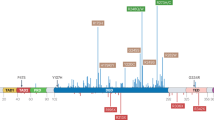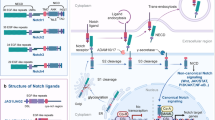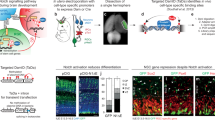Abstract
Signaling mediated by activation of the transmembrane receptor Notch influences cell-fate decisions, differentiation, proliferation, and cell survival. Activated Notch reduces proliferation by altering cell-cycle kinetics and promotes differentiation in hematopoietic progenitor cells. Here, we investigated if the G1 arrest and differentiation induced by activated mNotch1 are dependent on tumor suppressor p53, a critical mediator of cellular growth arrest. Multipotent wild-type p53-expressing (p53wt) and p53-deficient (p53null) hematopoietic progenitor cell lines (FDCP-mix) carrying an inducible mNotch1 system were used to investigate the effects of proliferation and differentiation upon mNotch1 signaling. While activated Notch reduced proliferation of p53wt-cells, no change was observed in p53null-cells. Activated Notch upregulated the p53 target p21cip/waf in p53wt-cells, but not in p53null-cells. Induction of the p21cip/waf gene by activated Notch was mediated by increased binding of p53 to p53-binding sites in the p21cip/waf promoter and was independent of the canonical RBP-J binding site. Re-expression of p53wt in p53null cells restored the inhibition of proliferation by activated Notch. Thus, activated Notch inhibits proliferation of multipotent hematopoietic progenitor cells via a p53-dependent pathway. In contrast, myeloid and erythroid differentiation was similarly induced in p53wt and p53null cells. These data suggest that Notch signaling triggers two distinct pathways, a p53-dependent one leading to a block in proliferation and a p53-independent one promoting differentiation.
Similar content being viewed by others
Log in or create a free account to read this content
Gain free access to this article, as well as selected content from this journal and more on nature.com
or
Abbreviations
- p53wt:
-
wild type p53
- p53null:
-
p53-deficient
- FDCP-mix:
-
factor-dependent cell established at the Paterson Institute with mixed differentiation potential
- mNotch1:
-
murine Notch1
- NotchIC:
-
intracellular domain of Notch
- RBP-J:
-
recombination recognition sequence binding protein at the Jκ site
- Hes:
-
hairy and enhancer of split
- Hey/Herp:
-
Hes-related repressor
- mN1IC:
-
intracellular domain of murine Notch1
- NERT:
-
mN1IC fused to the hormone binding domain of the human estrogen receptor tamoxifen-sensitive mutant
- ERT:
-
estrogen receptor tamoxifen-sensitive mutant
- rneo:
-
retroviral control vector carrying the neomyin resistance gene
- rNERTneo:
-
retroviral control vector carrying the NERT and neomyin resistance gene
- rNERTneo FDCP-mix:
-
FDCP-mix cells expressing an OHT-inducible form of Notch1IC
- rneo FDCP-mix:
-
FDCP-mix cells carrying the retroviral control vector conferring neomycin resistance
- G418:
-
neomycin
- OHT:
-
4-hydroxytamoxifen
- CFSE:
-
carboxyfluorescein diacetate succinimidyl ester
- p21RBP-Jmut promoter:
-
p21 promoter compromised in RBP-J binding
- IMDM:
-
Iscove's modified Dulbecco's medium
- FCS:
-
fetal calf serum
- PE:
-
Phycoerytrin
- APC:
-
allophycocyanin
- PBS:
-
phosphate-buffered saline
- RT:
-
room temperature
- p21luc:
-
reporter plasmid carrying a luciferase gene under the control of the p21 promoter
- p21Δp53BS1luc:
-
p21 promoter lacking the first p53 binding site
- p21Δp53BS2luc:
-
p21 promoter lacking the second p53 binding site
- p21Δp53BS1+2luc:
-
p21 promoter lacking both p53 binding sites
- ChIP:
-
chromatin immunoprecipitation
References
Wilson A, Radtke F . Multiple functions of Notch signaling in self-renewing organs and cancer. FEBS Lett 2006; 580: 2860–2868.
Lai EC . Notch signaling: control of cell communication and cell fate. Development 2004; 131: 965–973.
Hurlbut GD, Kankel MW, Lake RJ, Artavanis-Tsakonas S . Crossing paths with Notch in the hyper-network. Curr Opin Cell Biol 2007; 19: 166–175.
Honjo T . The shortest path from the surface to the nucleus: RBP-J kappa/Su(H) transcription factor. Genes Cells 1996; 1: 1–9.
Huang Q, Raya A, DeJesus P, Chao S-H, Quon K, Caldwell J et al. Identification of p53 regulators by genome-wide functional analysis. Proc Natl Acad Sci USA 2004; 101: 3456–3461.
Vogelstein B, Lane D, Levine A . Surfing the p53 network. Nature 2000; 408: 307–310.
Schroeder T, Just U . mNotch1 signaling reduces proliferation of myeloid progenitor cells by altering cell-cycle kinetics. Exp Hematol 2000; 28: 1206–1213.
Schroeder T, Kohlhof H, Rieber N, Just U . Notch signaling induces multilineage myeloid differentiation and up-regulates Pu.1 expression. J Immunol 2003; 170: 5538–5548.
Schroeder T, Just U . Notch signalling via RBP-J promotes myeloid differentiation. EMBO J 2000; 19: 2558–2568.
Spooncer E, Heyworth CM, Dunn A, Dexter TM . Self-renewal and differentiation of interleukin-3-dependent multipotent stem cells are modulated by stromal cells and serum factors. Differentiation 1986; 31: 111–118.
Pierce A, Spooncer E, Wooley S, Dive C, Francis J, Miyan J et al. Bcr-Abl protein tyrosine kinase activity induces a loss of p53 protein that mediates a delay in myeloid differentiation. Oncogene 2000; 19: 5487–5497.
Just U, Stocking C, Spooncer E, Dexter TM, Ostertag W . Expression of the GM-CSF gene after retroviral transfer in hematopoietic stem cell lines induces synchronous granulocyte- macrophage differentiation. Cell 1991; 64: 1163–1173.
Just U, Boettiger D, Kan O, Dexter TM, Spooncer E . Insertional mutagenesis as a route to identifying genes involved in self renewal of haemopoietic stem cells. Curr Top Microbiol Immunol 2000; 251: 27–34.
Lyons A, Parish C . Determination of lymphocyte division by flow cytometry. J Immunol Methods 1994; 171: 131–137.
Niwa H, Masui S, Chambers I, Smith AG, Miyazaki J . Phenotypic complementation establishes requirements for specific POU domain and generic transactivation function of Oct-3/4 in embryonic stem cells. Mol Cell Biol 2002; 22: 1526–1536.
Sherr C, Roberts J . CDK inhibitors:positive and negative regulators of G1-phase progression. Genes Dev 1999; 13: 1501–1512.
El-Deiry WS, Tokino T, Velculescu VE, Levy DB, Parsons R, Trent JM et al. WAF1, a potential mediator of p53 tumor suppression. Cell 1993; 75: 817–825.
Rangarajan A, Talora C, Okuyama R, Nicolas M, Mammucari C, Oh H et al. Notch signaling is a direct determinant of keratinocyte growth arrest and entry into differentiation. EMBO J 2001; 20: 3427–3436.
Tun T, Hamaguchi Y, Matsunami N, Furukawa T, Honjo T, Kawaichi M . Recognition sequence of a highly conserved DNA binding protein RBP-J. Nucleic Acids Res 1994; 22: 965–971.
Henning K, Schroeder T, Schwanbeck R, Rieber N, Bresnick EH, Just U . mNotch1 signalling and erythropoietin cooperate in erythroid differentiation of multipotent progenitor cells by upregulation of b-globin. Exp Hematol 2007; 35: 1321–1332.
Allan LA, Duhig T, Read M, Fried M . The p21(WAF1/CIP1) promoter is methylated in Rat-1 cells; stable restoration of p53-dependent p21 (WAF1/CIP1) expression after transfection of a genomic clone containing the p21(WAF1/CIP1) gene. Mol Cell Biol 2000; 20: 1291–1298.
Qi R, An H, Yu Y, Zhang M, Liu S, Xu H et al. Notch1 signaling inhibits growth of human hepatocellular carcinoma through induction of cell cycle arrest and apoptosis. Cancer Res 2003; 63: 8323–8329.
Talora C, Cialfi S, Segatto O, Morrone S, Kim Choi J, Frati L et al. Constitutively active Notch1 induces growth arrest of HPV-positive cervical cancer cells via separate signaling pathways. Exp Cell Res 2005; 305: 343–354.
Yang X, Klein R, Tian X, Cheng HT, Kopan R, Shen J . Notch activation induces apoptosis in neural progenitor cells through a p53-dependent pathway. Dev Biol 2004; 269: 81–94.
Ong C-T, Cheng H-T, Chang L-W, Ohtsuka T, Kageyama R, Stormo G et al. Target selectivity of vertebrate Notch proteins: collaboration between discrete domains and CSL-binding site architecture determines activation probability. J Biol Chem 2006; 281: 5106–5119.
Mammucari C, Tommasi di Vignano A, Sharov A, Neilson J, Havrda M, Roop D et al. Integration of Notch1 and calcineurin/NFAT signaling pathways in keratinocyte growth and differentiation control. Dev Cell 2005; 8: 665–676.
Xu Y . Regulation of p53 responses by post-translational modifications. Cell Death Diff 2003; 10: 400–403.
Knights CD, Catania J, Di Giovanni S, Muratoglu S, Perez R, Swartzbeck A et al. Distinct p53 acetylation cassettes differentially influence gene-expression patterns and cell fate. J Biol Chem 2007; 173: 533–544.
Kim SB, Chae GW, Park J, Tak H, Chung JH, Park TG et al. Activated Notch1 interacts with p53 to inhibit its phosphorylation and transactivation. Cell Death Diff 2007; 14: 982–991.
Nair P, Somasundaram K, Krishna S . Activated Notch1 inhibits p53-induced apoptosis and sustains transformation by human papillomavirus type 16 E6 and E7 oncogenes through a PI3K-PKB/Akt-dependent pathway. J Virol 2003; 77: 7106–7112.
Mungamuri S, Yang X, Thor A, Somasundaram K . Survival signaling by Notch1:mammalian target of rapamycin (mTOR)-dependent inhibition of p53. Cancer Res 2006; 66: 4715–4724.
Beverly L, Felsher D, Capobianco A . Suppression of p53 by Notch in lymphomagenesis: implications for initiation and regression. Cancer Res 2005; 65: 7159–7168.
Cheng T, Rodrigues N, Shen H, Yang Y, Dombkowski D, Sykes M et al. Hematopoietic stem cell quiescence maintained by p21cip1/waf1. Science 2000; 287: 1804–1808.
van Os B, Kamminga L, Ausema A, Bystrykh L, Draijer D, van Pelt K et al. A limited role for p21cip1/waf1 in maintaining normal hematopoietic stem cell function. Stem Cells 2007; 25: 836–843.
TeKippe M, Harrison DE, Chen J . Expansion of hematopoietic stem cell phenotype and activity in Trp53-null mice. Exp Hematol 2003; 31: 521–527.
Schroeder T, Lange C, Strehl J, Just U . Generation of functionally mature dendritic cells from the multipotential stem cell line FDCP-mix. Br J Haematol 2000; 111: 890–897.
Strobl LJ, Hofelmayr H, Stein C, Marschall G, Brielmeier M, Laux G et al. Both Epstein-Barr viral nuclear antigen 2 (EBNA2) and activated Notch1 transactivate genes by interacting with the cellular protein RBP-J kappa. Immunobiology 1997; 198: 299–306.
Kim E, Rohaly G, Heinrichs S, Gimnopoulos D, Meißner H, Deppert W . Influence of promoter DNA topology on sequence-specific DNA binding and transactivation by tumor suppressor p53. Oncogene 1999; 18: 7310–7318.
Kim E, Günther W, Yoshizato K, Meissner H, Zapf S, Nüsing RM et al. Tumor suppressor p53 inhibits transcriptional activation of invasion gene thromboxane synthase mediated by the proto-oncogenic factor ets-1. Oncogene 2003; 22: 7716–7727.
Schroeder T, Meier-Stiegen F, Schwanbeck R, Eilken H, Nishikawa S, Häsler R et al. Activated Notch1 alters differentiation of embryonic stem cells into mesodermal cell lineages at multiple stages of development. Mech Dev 2006; 123: 570–579.
Acknowledgements
We thank Silke Horn, Cornelia Kuklik-Roos and Gabriele Warnecke for expert technical support and Elaine Spooncer and Michael Dexter for the p53null FDCP-mix cell lines. This work was supported by the Deutsche Forschungsgemeinschaft (Priority Program 1109 ‘Stem Cells’ and SFB 415 ‘Signal Transduction’ project B8 to UJ). This report represents a part of the doctoral thesis by KH and of the diploma thesis of JH.
Author information
Authors and Affiliations
Corresponding author
Additional information
Edited by M Oren
Rights and permissions
About this article
Cite this article
Henning, K., Heering, J., Schwanbeck, R. et al. Notch1 activation reduces proliferation in the multipotent hematopoietic progenitor cell line FDCP-mix through a p53-dependent pathway but Notch1 effects on myeloid and erythroid differentiation are independent of p53. Cell Death Differ 15, 398–407 (2008). https://doi.org/10.1038/sj.cdd.4402277
Received:
Revised:
Accepted:
Published:
Issue date:
DOI: https://doi.org/10.1038/sj.cdd.4402277
Keywords
This article is cited by
-
TRAIL-receptor 2—a novel negative regulator of p53
Cell Death & Disease (2021)
-
Crosstalk of Notch with p53 and p63 in cancer growth control
Nature Reviews Cancer (2009)



